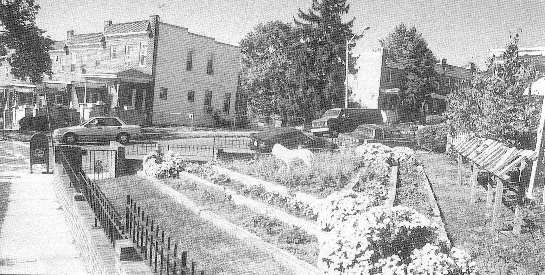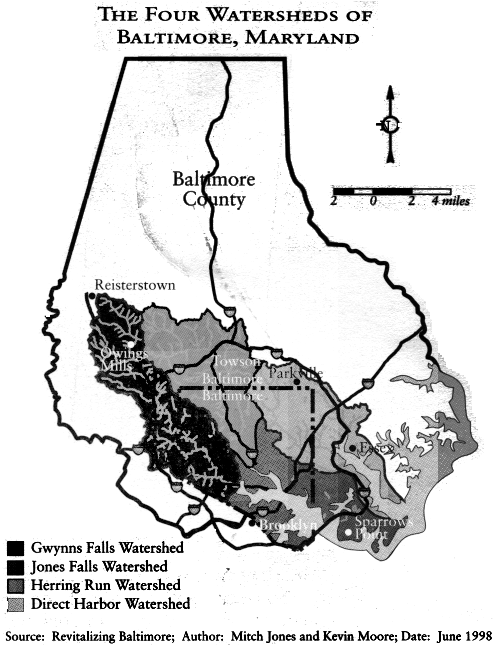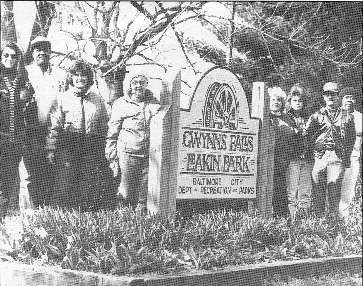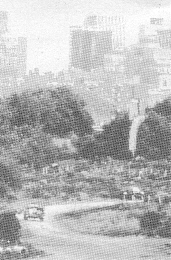

"From a scientific perspective, we know very little about how these ecosystems operate."
 |
| All pictures by: Parks and People Foundation |
When we think of ecosystems, we usually think of forests, deserts, prairies, the Arctic, lakes or estuaries like the Chesapeake Bay - and of the plants and animals that live in them. We often forget that people are an important part of many ecosystems and, in heavily populated areas such as cities, they have a major impact on them. According to Steward Pickett, metropolitan areas have gone largely unstudied as ecosystems in their own right, a serious oversight when one considers that some 75 percent of the U.S. population is now concentrated in cities and their surrounding suburbs.
From a scientific perspective, we know very little about how these ecosystems operate, says Pickett of the Institute of Ecosystem Studies in Millbrook, New York. He has been a leader in calling for sustained research on the ecology of urban centers, citing very practical reasons that relate to how new development and restoration is planned in these areas. "Ecological research needs to be focused more directly on populated areas, "he says, "to yield scientific understanding as well as generate expertise for policy makers." The inability to predict ecosystem effects of landuse changes - whether in residential neighborhoods, commercial districts or fringing rural areas that face intense land transformation - means that planning decisions are often made in the dark.
Equally important, Pickett observes, ecologists have largely ignored the changing relationships between humans and ecosystems. Such an understanding requires more than knowledge of physical and biological science, says William Burch of the Yale University School of Forestry and Environmental Studies. Since human beings and their communities play an integral role in how urban and suburban landscapes evolve, we need to understand how these changes come about and what social, cultural and political influences drive them. Also, how are human choices, in turn, affected by changes in the environment itself?
"What we need," Pickett says, "is a new ecological understanding of how people behave and affect ecological systems." Most ecologists have not been used to doing this, he adds. "It requires that we integrate substantially with social scientists."
It is this unique challenge of joining environmental and human dimensions that has led Pickett, Burch and a team of ecologists, social scientists, foresters and geographers to become engaged in the Baltimore Ecosystem Study. With core funding from the National Science Foundation, this urban analysis forms part of NSF's LongTerm Ecological Research Program, which has supported studies on "natural" systems and now, for the first time, two urban projects - in Baltimore, Maryland and Phoenix, Arizona.
"This is an immensely complex and pioneering effort," Pickett says, which includes substantial support from the U.S. Department of Agriculture Forestry Service and participation by many partners, including the U.S. Geological Survey, Baltimore City, Baltimore County and the Maryland Department of Natural Resources. It not only focuses on the effects people have on the largely urbanized Baltimore watershed, but also attempts to understand the social behaviors that underlie those impacts - - as well as attempts to involve the people themselves both in the study

and in the improved decisionmaking that researchers hope will result. It is for these reasons that neighborhood outreach programs and summer institutes for teachers are such key elements of the study.
Suburban Sprawl and Urban In-filling
Throughout the nation, measures to put the brakes on accelerated development of rural areas have set off firestorms of debate and controversy. Cover the last two years, for example, several hundred initiatives to curb the loss of open space have appeared on ballots around the U.S. They include measures like Maryland's Smart Growth initiative, measures which aim to preserve forests, wetlands and rural areas and to foster redevelopment of metropolitan areas, especially cities that over the last several decades have experienced population losses and abandonment of commercial and residential buildings. These measures guide growth toward areas where roads and streets, along with underground sewage pipes and stormwater drains, are already in place.
From an environmental perspective, arguments for filling in urban and suburban areas with more built structures might at first seem paradoxical - an unlikely way to protect streams and rivers. For example, vegetated areas protect aquatic systems by slowing and absorbing runoff; conversely, streets and buildings may serve as conduits for speeding rainwater, often laden with contaminants, into stormwater drains and streams. Many planners counter, however, that by in-filling urban centers, we have a better chance to control and consolidate wastes, treating them more efficiently before they drain into the Bay's tributaries.
While innovative planners around the country are testing techniques for curbing contaminants from urban runoff, employing these techniques widely to improve streams and rivers presents an enormously expensive challenge. To a large extent, the arguments for and against these efforts run up against a lack of "hard" knowledge for predicting their effectiveness, whether they involve
 diversions or streamside tree plantings. For example, what factors matter most for buffering streams against contaminant runoff in order to improve water quality or biological diversity - the number of trees, their spatial configuration, particular species, some combination of these? What is the effect of soil type, of non-indigenous vegetation? Underlying these environmental questions are social issues. What drives changes in the physical landscape are often human choices, based on complex economic, political and cultural factors.
diversions or streamside tree plantings. For example, what factors matter most for buffering streams against contaminant runoff in order to improve water quality or biological diversity - the number of trees, their spatial configuration, particular species, some combination of these? What is the effect of soil type, of non-indigenous vegetation? Underlying these environmental questions are social issues. What drives changes in the physical landscape are often human choices, based on complex economic, political and cultural factors.
Getting Started on Research
To begin getting a handle on the ecology of a metropolitan area and the relationships with its diverse neighborhoods, says Pickett, "we need to break the landscape components into ecologically differentiated parts." Rather than focusing on Baltimore as a whole, researchers need to work at a more manageable scale. They looked for a watershed that is small but still large enough to represent Baltimore's social and cultural diversity and its range of landscapes, from dense industrial and business zones to urban neighborhoods and suburban communities to more sparsely inhabited enclaves.
Gwynns Falls, one of four watersheds in Baltimore, fits these requirements, with just under 360,000 people (1990 census). Its southern end is predominantly residential, commercial and industrial, while the northern part includes agricultural, forested and open space areas, though land is already being cleared for development. According to The Gwynns Falls Ecological Resource Atlas, more than 75 percent of the watershed is already developed, with greater than 40 percent of the land covered by impermeable surfaces.
The initial ecological focus is on hydrological processes, the movement of water, nutrients and carbon as they flow from various built and natural habitats into streams and creeks. While Gwynns Falls is the initial focus of research, field sites will eventually be located throughout metropolitan Baltimore. In the long run, says William Burch, they want to know the cumulative effect on the Chesapeake Bay. "That is the bottom line."
Larry Band, a geographer from the University of North Carolina, is developing computer models that will eventually enable researchers to examine the effects of landscape changes, such as the planting of trees and the installation of drainage systems in catchment areas of Gwynns Falls. Based on approaches that ecologists have developed over the last 20 years, a region is first divided into separate segments or patches, each of which will exhibit different flows of water, nutrients and carbon, depending on the mix in each patch of impervious surfaces, natural land cover, types of soil, storm and sanitary sewer systems. Mathematical models of flows from one patch to another are then linked. Band has begun work by developing models for smaller subwatersheds in Gwynns Falls that will enable researchers to simulate the effects on local streams of changes in surrounding landscapes.
Models are mathematical mimics -- they are only as good as the quality of the data that they use. A major effort of the Baltimore Ecosystem Study is to collect long-term data on different configurations of built and natural landscapes, seasonally and over many years in order to better understand how changes to these landscapes affect streams and the rivers they feed. Towards these ends, for example, Peter Groffman of the Institute of Ecosystem Studies began a series of long-term measurements that are comparing how stream banks (riparian zones) in rural and urban areas in Gwynns Falls affect dentrification - a microbial process that converts potentially harmful nitrate
into nitrogen gas and helps cleanse the system of excess nutrients. "The ability of riparian zones to process water is important," Groffman says. "In many areas, they have been shown to prevent the movement of pollutants from upland land uses to streams." Groffman notes, though, that efficiency depends on a number of factors, including the kind of vegetation that grows along a stream bank. Focusing on eight riparian zones - four rural and four urban - he found surprisingly that urban riparian zones can support high rates of denitrification, though there was a great deal of variability there, more so than in rural sites. In urban areas, Groffman says, what we have done is to isolate riparian zones; in the long run, he adds, we need to develop innovative ways for reconnecting them.
Groffman's riparian sites represent only one of the numerous research and monitoring projects already underway. For example, vegetation plots in three Gwynns Falls forests - two in the city and one in a less-developed area in Oregon Ridge - are being monitored to track changes in species of trees, shrubs, vines and herbs over time. In another study, differences in nutrient cycling are being compared in a network of forest and grass plots; meanwhile, urban yards and wetlands will be added to the study.
Neighborhoods and Ecosystems
Human beings affect the structure of ecosystems, says Morgan Grove. "They change the course of a stream, they put trees up and take them down. That affects water, the evaporation from trees, the way that water lands on a roof top, goes in a gutter and down into a drain - and that affects other processes." Grove, who is with the USDA's Forestry Service in Burlington, Vermont, is an integral member of the Baltimore Ecosystem Study. He originally came to Baltimore as a Yale graduate student under William Burch and worked with Baltimore's Recreation and Parks
 Department on natural resource management in helping to develop a community forestry program. Like Pickett and Burch, Grove is fervent about actively involving Baltimore communities in the research they are doing. "If we don't interact with communities, we don't get to do research," says Pickett. "We're doing this work in people's backyards and parks." This past summer, William Burch and Vicky Fabiyi organized a training session for researchers that introduced them to the Baltimore communities where they are conducting their research. They focused on the history, demographics and social characteristics of one community in the Gwynns Falls watershed.
Department on natural resource management in helping to develop a community forestry program. Like Pickett and Burch, Grove is fervent about actively involving Baltimore communities in the research they are doing. "If we don't interact with communities, we don't get to do research," says Pickett. "We're doing this work in people's backyards and parks." This past summer, William Burch and Vicky Fabiyi organized a training session for researchers that introduced them to the Baltimore communities where they are conducting their research. They focused on the history, demographics and social characteristics of one community in the Gwynns Falls watershed.
A basic premise of the Baltimore Ecosystem Study is that the socio-economic structures of neighborhoods affect local environmental factors--and these in turn affect quality of life. What factors go into the decisions that affect the ecosystem? "People have different lifestyles that are related to class, race, cultural background," Grove says, "and they may have characteristic ways in which they affect ecological processes, whether directly or indirectly." We want to try to understand these relationships, he says, for example, whether power structures in a region result in environmental inequities and, if so, how they occur. If people had a better understanding, he asks, would that affect their behavior in terms of power structures and the kinds of decisions they make?
Trying to answer such questions in a robust, empirical way is what Burch is after. "We're developing a methodology," he says, "for systematically
 measuring, identifying and describing changes in landuse [along with], housing, rise and fall of services, social bonding" and other traditional social science concerns. Burch then relates these to interactions with biophysical factors. Our aim, he says, is to try to match the ecological studies of patch dynamics with social groups. "This is not a common practice," says Burch with the air of understatement. "No built environment stays the same," he points out. "A new generation comes in and changes what the previous one has done. Can we build a predictive capability, he asks, so that people can intervene to minimize those costs, both ecologically and socially?"
measuring, identifying and describing changes in landuse [along with], housing, rise and fall of services, social bonding" and other traditional social science concerns. Burch then relates these to interactions with biophysical factors. Our aim, he says, is to try to match the ecological studies of patch dynamics with social groups. "This is not a common practice," says Burch with the air of understatement. "No built environment stays the same," he points out. "A new generation comes in and changes what the previous one has done. Can we build a predictive capability, he asks, so that people can intervene to minimize those costs, both ecologically and socially?"
Underlying the Baltimore Ecosystem Study is the idea that the value of ecological research does not stop with policy making but that it can serve much broader citizen purposes by involving students, educators and communities along the way. "When kids get involved in studying the real world," says Pickett, "the examples are fresh and new. Urban ecology gives them a sense that ecology is everywhere." The Baltimore Ecosystem Study may prove to be a unique model of how long-term support and collaborative research can help people improve the ecological health of the places they call home.![]()